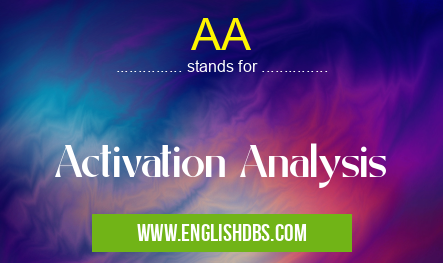What does AA mean in CHEMISTRY
Activation Analysis (AA), also known as Nuclear Activation Analysis, is a method of analytical chemistry used to determine the composition of materials. This technique uses neutron irradiation to induce reactions in the sample being analyzed that produce gamma-ray emissions. AA can identify and quantify elements present in a sample by measuring these gamma-ray energies and comparing them to energies produced by known elements. AA has many applications, such as analyzing marine life for pollutants, wastewater treatment, industrial production and medical diagnostics. This technique is highly sensitive to low concentrations of elements and is capable of detecting ultra trace amounts of elements that usually cannot be measured or identified by other methods.

AA meaning in Chemistry in Academic & Science
AA mostly used in an acronym Chemistry in Category Academic & Science that means Activation Analysis
Shorthand: AA,
Full Form: Activation Analysis
For more information of "Activation Analysis", see the section below.
Working Principle
AA involves exposing an element or sample to high levels of neutron radiation from a nuclear reactor or accelerator. Neutrons interact with nuclei of atoms in the sample, which causes them to become unstable or “activated”. Then, when these activated nuclei release their excess energy in the form of gamma rays, it can be detected using specialized instruments such as gamma spectrometers. These instruments measure the energy of each element's characteristic gamma ray emission and compare it against known values for each element allowing scientists to accurately identify and quantify all elements present in the sample.
Advantages
The main advantage of AA is its sensitivity and detection capability; this method can detect even ultra traces amounts (<1 part per billion) of elements that are not easily detected by other analytical techniques. In addition, because this technique does not require multiple steps like some other methods do, results are often obtained quickly and easily without laborious preparation required by some alternative methods. Finally, this method can be used on almost any type of sample including liquid samples, solids, powders or mixtures providing flexibility for analyzing various types of material including difficult items such as biological tissues or contaminated soils.
Disadvantages
Activation Analysis requires expensive instrumentation and expertise making it relatively costly compared to other analytical techniques; this makes it less accessible for certain applications where cost is an issue. Additionally, because nuclear reactors need to be handled with special care due to potential safety concerns it may limit access further if access to a nuclear reactor is not possible.
Essential Questions and Answers on Activation Analysis in "SCIENCE»CHEMISTRY"
What is Activation Analysis?
Activation Analysis is a type of nuclear analytical technique used to determine the elemental composition or concentration of a sample by measuring the energy of gamma rays emitted from radioisotopes produced through the nuclear reaction.
How does Activation Analysis work?
In Activation Analysis, radiation from a known source bombards or irradiates a sample material and creates an artificial radioisotope. This radioisotope then decays emitting gamma rays which can be measured in order to calculate the concentration of relevant elements present in the sample.
What types of samples can be analysed using Activation Analysis?
Almost any type of material can be analysed using Activation Analysis, such as medical and pharmaceutical samples, industrial waste products, soil samples, rocks and minerals.
What are some advantages to using Activation Analysis for analysing materials?
Some advantages to using Activation Analysis for analysing materials include its ability to measure trace elements that would otherwise be undetectable, its highly sensitive nature and its non-destructive testing methods.
What type of technology is used in an Activation Analysis system?
An Activation Analysis system typically consists of an irradiation chamber and gamma ray detector such as a scintillation detector or Geiger Muller tube. The detectors measure and record the energy levels of gamma rays emitted from the sample being tested so that results can be obtained quickly and accurately.
How accurate is Activation Analysis compared to other analytical techniques?
When set up correctly, Activation Analysis results are typically very accurate due to its highly sensitive nature and ability to detect trace elements that would otherwise go unnoticed. However it should be noted that accuracy can also depend on the quality of equipment being used for analysis.
Is there potential health risks associated with performing an activation analysis?
Yes. As with any type of nuclear analytical technique involving radioactive sources, safety precautions must be taken when performing activation analysis in order to avoid potential risks associated with hazardous radiation exposure. It is important that proper protocols and safety measures are followed at all times during any activitation analysis procedures.
Are there different types of activation analyses available depending on the sample being tested?
Yes, depending on what kind of information you need about your sample, different types of activitation analyses may be required in order to get accurate results. These may include neutron activation analysis (NAA), fast neutron activation analysis (FNAA) or thermal neutron activation analysis (TNAA).
Final Words:
In conclusion, Activation Analysis (AA) is an important analytical tool used to identify and quantify compounds present in samples at ultra trace concentrations (<1ppb). AA provides quick results with minimal sample preparation making it ideal for numerous applications ranging from environmental research to medical diagnostics. While expensive instrumentation may limit access for certain applications cost should not prevent taking advantage of this valuable technique whenever available.
AA also stands for: |
|
| All stands for AA |
